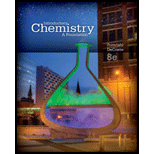
Introductory Chemistry: A Foundation
8th Edition
ISBN: 9781285199030
Author: Steven S. Zumdahl, Donald J. DeCoste
Publisher: Cengage Learning
expand_more
expand_more
format_list_bulleted
Textbook Question
Chapter 10, Problem 61QAP
If a reaction occurs readily but has an endothermic heat of reaction, what must be the driving force for the reaction?
Expert Solution & Answer
Trending nowThis is a popular solution!

Students have asked these similar questions
Using the appropriate bond energies, calculate the heat of reaction AH for the following reaction:
H-H + CI-CI
2 H-CI
You can find a table of bond energies by using the Data button on the ALEKS toolbar.
Round your answer to the nearest kJ/mol.
Note: For clarity, all lone pairs have been omitted from the molecular structures.
☐
kJ
mol
ค
000
Ar
B
Predict the hydrocarbon, of formula C6H10, needed to prepare the following geminal dibromide upon treatment with excess hydrobromic acid.
Note: The shown product is the only regioisomer formed in this reaction.
HBr
H₂C.
CH3
draw the major product formed with the listed reagents
Chapter 10 Solutions
Introductory Chemistry: A Foundation
Ch. 10.1 - at if energy were not conserved? How would this...Ch. 10.4 - u are calculating in a chemistry problem. What if...Ch. 10.5 - ercise 10.1 How many calories of energy correspond...Ch. 10.5 - ercise 10.2 Calculate the joules of energy...Ch. 10.5 - ercise 10.3 A 5.63-g sample of solid gold is...Ch. 10.5 - ercise 10.4 A 2.8-g sample of pure metal requires...Ch. 10.6 - Prob. 10.5SCCh. 10.7 - at if Hess’s law were not true? What are some...Ch. 10.7 - Prob. 10.6SCCh. 10.9 - Prob. 1CT
Ch. 10.10 - at if the first law of thermodynamics was true,...Ch. 10 - Prob. 1ALQCh. 10 - friend of yours reads that the process of water...Ch. 10 - ou place hot metal into a beaker of cold water. ol...Ch. 10 - Prob. 4ALQCh. 10 - Prob. 5ALQCh. 10 - xplain why aluminum cans make good storage...Ch. 10 - n Section 10.7, two characteristics of enthalpy...Ch. 10 - Prob. 8ALQCh. 10 - hat is meant by the term driving forces? Why are...Ch. 10 - Prob. 10ALQCh. 10 - Explain in your own words what is meant by the...Ch. 10 - Prob. 12ALQCh. 10 - What if energy was not conserved? How would this...Ch. 10 - The internal energy of a system is said to be the...Ch. 10 - Hydrogen gas and oxygen gas react violently to...Ch. 10 - Consider four 100.0-g samples of water, each in a...Ch. 10 - For each of the following situations ac. use the...Ch. 10 - Prob. 18ALQCh. 10 - Does the entropy of the system increase or...Ch. 10 - Prob. 20ALQCh. 10 - Prob. 1QAPCh. 10 - Prob. 2QAPCh. 10 - Prob. 3QAPCh. 10 - Prob. 4QAPCh. 10 - Prob. 5QAPCh. 10 - n Fig. 10.1, what kind of energy does ball A...Ch. 10 - Prob. 7QAPCh. 10 - f you spilled a cup of freshly brewed hot tea on...Ch. 10 - Prob. 9QAPCh. 10 - Prob. 10QAPCh. 10 - In studying heat flows for chemical processes,...Ch. 10 - When a chemical system evolves energy, where does...Ch. 10 - The combustion of methane, is an exothermic...Ch. 10 - Are the following processes exothermic or...Ch. 10 - What do we mean by thermodynamics? What is the...Ch. 10 - Prob. 16QAPCh. 10 - Calculate A£ for each of the following cases q =...Ch. 10 - If q for a process is a positive number, then the...Ch. 10 - For an endothermic process, q will have a...Ch. 10 - A system releases 125 kJ of heat and 104 kJ of...Ch. 10 - Prob. 21QAPCh. 10 - Prob. 22QAPCh. 10 - If 8.40 kJ of heat is needed to raise the...Ch. 10 - If it takes 654 J of energy to warm a 5.51-g...Ch. 10 - Prob. 25QAPCh. 10 - Prob. 26QAPCh. 10 - Covert the following numbers of kilojoules into...Ch. 10 - Prob. 28QAPCh. 10 - Prob. 29QAPCh. 10 - Prob. 30QAPCh. 10 - .5 kJ of heat is applied to a 1012-g block of...Ch. 10 - What quantity of heat energy must have en applied...Ch. 10 - If 125 J of heat energy is applied to a block of...Ch. 10 - If 100. J of heat energy is applied to a 25-g...Ch. 10 - What quantity of heat is required to raise the...Ch. 10 - Prob. 36QAPCh. 10 - The “Chemistry in Focus” segment Nature Has Hot...Ch. 10 - In the “Chemistry in Focus” segment Firewalking:...Ch. 10 - Prob. 39QAPCh. 10 - A _________ is a device used to determine the heat...Ch. 10 - The enthalpy change for the reaction of hydrogen...Ch. 10 - For the reaction kJ per mole of formed. Calculate...Ch. 10 - Prob. 43QAPCh. 10 - When ethanol (grain alcohol, is burned in oxygen,...Ch. 10 - Prob. 45QAPCh. 10 - Prob. 46QAPCh. 10 - Prob. 47QAPCh. 10 - Prob. 48QAPCh. 10 - Prob. 49QAPCh. 10 - Prob. 50QAPCh. 10 - Prob. 51QAPCh. 10 - Prob. 52QAPCh. 10 - Prob. 53QAPCh. 10 - Prob. 54QAPCh. 10 - Prob. 55QAPCh. 10 - Prob. 56QAPCh. 10 - Prob. 57QAPCh. 10 - Prob. 58QAPCh. 10 - Prob. 59QAPCh. 10 - Prob. 60QAPCh. 10 - If a reaction occurs readily but has an...Ch. 10 - Prob. 62QAPCh. 10 - Prob. 63QAPCh. 10 - Prob. 64QAPCh. 10 - Prob. 65APCh. 10 - Calculate the enthalpy change when 1.0(1 g of...Ch. 10 - Prob. 67APCh. 10 - Calculate the amount of energy required (in...Ch. 10 - If takes 1.25 kJ of energy to heat a certain...Ch. 10 - What quantity of heat energy would have to be...Ch. 10 - The specific heat capacity of gold is 0.13 J/g °C....Ch. 10 - Calculate the amount of energy required (in...Ch. 10 - If 10. J of heat is applied to 5.0-g samples of...Ch. 10 - A 50.1)-g sample of water at 100. °C is poured...Ch. 10 - A 25.0-g sample of pure iron at 85 °C is dropped...Ch. 10 - If 7.24 kJ of heat is applied to a 952-g block of...Ch. 10 - For each of the substances listed in Table 10.1,...Ch. 10 - A system releases 213 kJ of heat and has a...Ch. 10 - Prob. 79APCh. 10 - Calculate the enthalpy change when 5.00 g of...Ch. 10 - Prob. 81APCh. 10 - Prob. 82APCh. 10 - It has been determined that the body can generate...Ch. 10 - Prob. 84APCh. 10 - Prob. 85CPCh. 10 - The specific heat capacity of graphite is 0.71 J/g...Ch. 10 - A swimming pool, 10.0 in by 4.0 m, is filled with...Ch. 10 - Prob. 88CPCh. 10 - Prob. 89CP
Knowledge Booster
Learn more about
Need a deep-dive on the concept behind this application? Look no further. Learn more about this topic, chemistry and related others by exploring similar questions and additional content below.Similar questions
- Propose Williamson ether syntheses for the following compoundsarrow_forwardIdentify all functional groupsarrow_forwardA mixture of CaCO3 and MgC2O4 of unknown mass was heated in a 0.5 L closed rigid vessel to 900 degrees C.at 400C the following reaction occurs:MgC2O4 -> MgO (s) + CO (g) + CO2 (g)At 700C a second reaction occurs: CaCO3 -> CaO (s) + CO2 (g)The solid mass in the vessel was measured to be 3.06 g at 400C and 2.03g at 900CQuestion: What is the partial pressure of CO in both temperatures? (400 and 900C), provide detailed explanation.arrow_forward
- For the following alkyne, complete the reaction sequentially (that is draw the intermediate that we can’t stop at) and then name (complete name) all 3 molecules.arrow_forwardGiven the reaction sequence below, answer the following. A. Provide the structure for A. B. Provide the structure for B (pay attention to stereochemistry). C. Provide the structure for C. D. What are the stereochemical designations for I and II (R/S)?arrow_forwardWhich of the following is the most stable carbon radical?arrow_forward
- Put the following carbon radicals in order of increasing stability.arrow_forwardDraw the major organic product for each of the following reactions (pay attention to stereochemistry).arrow_forwardThere are 2 reactions (that you know of) to achieve the following transformation: One reaction is favored over the other because it avoids a competing reaction. A. Draw the favored reaction scheme (not the mechanism), be sure to include all necessary reagents. B. Draw the reaction scheme that is not favored and include all the possible products.arrow_forward
- Both carbocations and carbon-radicals have trigonal planar geometry. True or Falsearrow_forwardTeflon (polytetrafluoroethene) is prepared via the radial polymerization of tetrafluoroethene. What other reaction conditions (reagent, etc.) are needed to accomplish this? A. NBS, Light B. Heat, Cl2 C. Peroxide, Heat D. H2SO4, H2O, Heatarrow_forwardWhich of the following compounds can be reacted with ethene to prepare 1,1- dichlorocyclopropane? A. CCl4 B. CCl2 C. CHCl3 D. CH2Cl2arrow_forward
arrow_back_ios
SEE MORE QUESTIONS
arrow_forward_ios
Recommended textbooks for you
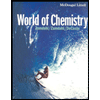 World of ChemistryChemistryISBN:9780618562763Author:Steven S. ZumdahlPublisher:Houghton Mifflin College DivChemistry: Matter and ChangeChemistryISBN:9780078746376Author:Dinah Zike, Laurel Dingrando, Nicholas Hainen, Cheryl WistromPublisher:Glencoe/McGraw-Hill School Pub Co
World of ChemistryChemistryISBN:9780618562763Author:Steven S. ZumdahlPublisher:Houghton Mifflin College DivChemistry: Matter and ChangeChemistryISBN:9780078746376Author:Dinah Zike, Laurel Dingrando, Nicholas Hainen, Cheryl WistromPublisher:Glencoe/McGraw-Hill School Pub Co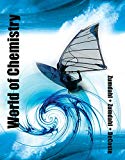 World of Chemistry, 3rd editionChemistryISBN:9781133109655Author:Steven S. Zumdahl, Susan L. Zumdahl, Donald J. DeCostePublisher:Brooks / Cole / Cengage Learning
World of Chemistry, 3rd editionChemistryISBN:9781133109655Author:Steven S. Zumdahl, Susan L. Zumdahl, Donald J. DeCostePublisher:Brooks / Cole / Cengage Learning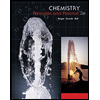 Chemistry: Principles and PracticeChemistryISBN:9780534420123Author:Daniel L. Reger, Scott R. Goode, David W. Ball, Edward MercerPublisher:Cengage Learning
Chemistry: Principles and PracticeChemistryISBN:9780534420123Author:Daniel L. Reger, Scott R. Goode, David W. Ball, Edward MercerPublisher:Cengage Learning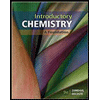 Introductory Chemistry: A FoundationChemistryISBN:9781337399425Author:Steven S. Zumdahl, Donald J. DeCostePublisher:Cengage Learning
Introductory Chemistry: A FoundationChemistryISBN:9781337399425Author:Steven S. Zumdahl, Donald J. DeCostePublisher:Cengage Learning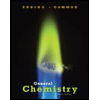 General Chemistry - Standalone book (MindTap Cour...ChemistryISBN:9781305580343Author:Steven D. Gammon, Ebbing, Darrell Ebbing, Steven D., Darrell; Gammon, Darrell Ebbing; Steven D. Gammon, Darrell D.; Gammon, Ebbing; Steven D. Gammon; DarrellPublisher:Cengage Learning
General Chemistry - Standalone book (MindTap Cour...ChemistryISBN:9781305580343Author:Steven D. Gammon, Ebbing, Darrell Ebbing, Steven D., Darrell; Gammon, Darrell Ebbing; Steven D. Gammon, Darrell D.; Gammon, Ebbing; Steven D. Gammon; DarrellPublisher:Cengage Learning

World of Chemistry
Chemistry
ISBN:9780618562763
Author:Steven S. Zumdahl
Publisher:Houghton Mifflin College Div

Chemistry: Matter and Change
Chemistry
ISBN:9780078746376
Author:Dinah Zike, Laurel Dingrando, Nicholas Hainen, Cheryl Wistrom
Publisher:Glencoe/McGraw-Hill School Pub Co

World of Chemistry, 3rd edition
Chemistry
ISBN:9781133109655
Author:Steven S. Zumdahl, Susan L. Zumdahl, Donald J. DeCoste
Publisher:Brooks / Cole / Cengage Learning

Chemistry: Principles and Practice
Chemistry
ISBN:9780534420123
Author:Daniel L. Reger, Scott R. Goode, David W. Ball, Edward Mercer
Publisher:Cengage Learning

Introductory Chemistry: A Foundation
Chemistry
ISBN:9781337399425
Author:Steven S. Zumdahl, Donald J. DeCoste
Publisher:Cengage Learning

General Chemistry - Standalone book (MindTap Cour...
Chemistry
ISBN:9781305580343
Author:Steven D. Gammon, Ebbing, Darrell Ebbing, Steven D., Darrell; Gammon, Darrell Ebbing; Steven D. Gammon, Darrell D.; Gammon, Ebbing; Steven D. Gammon; Darrell
Publisher:Cengage Learning
The Laws of Thermodynamics, Entropy, and Gibbs Free Energy; Author: Professor Dave Explains;https://www.youtube.com/watch?v=8N1BxHgsoOw;License: Standard YouTube License, CC-BY